SCIENTIFIC INSTRUMENTS ANCIENT AND MODERN
Celebrating 25 Years of The Caltech Archives 1968–1993
 Even before the dawn of recorded history, mankind's tools tell of a relentless quest for mastery over the natural world. To build a straight wall, navigate a true course, or determine the composition of matter—all require instruments adequate to the task.
Even before the dawn of recorded history, mankind's tools tell of a relentless quest for mastery over the natural world. To build a straight wall, navigate a true course, or determine the composition of matter—all require instruments adequate to the task.
Often the tools themselves are objects of striking beauty. In some cases, the investigators have been their own craftsmen. Maybe they have formed alliances with instrument makers. But in all instances of toolmaking, there has been a partnership between science and craft, between the desire to know and the means to find out.
This exhibit presents selected instruments and artifacts from the collections of the Caltech Archives. From ancient Egypt, the lands of Islam, and Renaissance Europe come a variety of small but precious objects. Colonial American science is represented by its most famous practitioner, Benjamin Franklin. Two prominent firms from Victorian Britain, the Cambridge Scientific Instrument Company and James White of Glasgow, contribute instruments capable of sophisticated electrical measurements. And from Caltech's own instrument shop in modern Pasadena comes a series of Robert Millikan's original cosmic-ray apparatus.
EXHIBIT FEATURES
Tycho Brahe with his mural quadrant
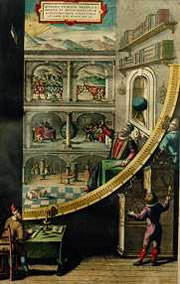 Tycho Brahe was the greatest observational genius in astronomy before the age of the telescope. Under the patronage of the King of Denmark, he built and operated the observatory of Uraniborg, which was filled with elaborate instruments of his own design. The mural, or Tychonian, quadrant was actually a very large brass quadrant, affixed to a wall. Its radius measured almost two meters and was graduated in tens of seconds. Sightings were taken along the quadrant through the small window in the opposing wall, to which Tycho points. The clock shown at the bottom right, accurate to seconds, allowed the observers to note the precise moment of observation.
Tycho Brahe was the greatest observational genius in astronomy before the age of the telescope. Under the patronage of the King of Denmark, he built and operated the observatory of Uraniborg, which was filled with elaborate instruments of his own design. The mural, or Tychonian, quadrant was actually a very large brass quadrant, affixed to a wall. Its radius measured almost two meters and was graduated in tens of seconds. Sightings were taken along the quadrant through the small window in the opposing wall, to which Tycho points. The clock shown at the bottom right, accurate to seconds, allowed the observers to note the precise moment of observation.
This picture is one leaf of a set of unbound book signatures from the collection of Earnest Watson. The signatures once belonged to volume one of the great eleven-volume Atlas maior by the well-known seventeenth-century cartographer Joan (or Jan) Blaeu of Amsterdam. Printed in 1662, Blaeu's elegantly executed and handsomely colored prints were actually copied from Tycho Brahe's Astronomiae instauratae mechanica, first published in 1598.
Earnest Watson (1892-1970)
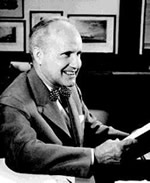 The collecting of treasures in the history of science was Earnest Watson's passion. Over the years, he purchased for Caltech and for his private collection many choice books, prints, rare artifacts and historic apparatus.
The collecting of treasures in the history of science was Earnest Watson's passion. Over the years, he purchased for Caltech and for his private collection many choice books, prints, rare artifacts and historic apparatus.
Watson arrived in Pasadena in 1919 to take up a position as assistant professor of physics at Throop College. Having already served as Robert Millikan's trusted graduate assistant at the University of Chicago, he wold play a prominent role at Caltech during the Millikan years as teacher, public lecturer and administrator. The Caltech Watson Lectures are named in his honor.
Early Egyptian statuette of Imhotep & replica

 Imhotep (left image) is referred to as "the first engineer" since he is reputed to have been the builder of the first pyramid. He lived during Egypt's Third Dynasty. The bronze statuette rests on a wood base which bears the marking: "XVII[th dynasty], Tel el Amarna." This would date the statuette between 1530 and 1320 B.C.
Imhotep (left image) is referred to as "the first engineer" since he is reputed to have been the builder of the first pyramid. He lived during Egypt's Third Dynasty. The bronze statuette rests on a wood base which bears the marking: "XVII[th dynasty], Tel el Amarna." This would date the statuette between 1530 and 1320 B.C.
Purchased for the Institute by Earnest Watson, 1957. The plaster model of the early Egyptian statuette (right image) was presented to the Caltech Class of 1939 by Earnest Watson and John R. MacArthur.
MacArthur was Professor of Languages for many years, and Dean of Freshmen from 1923 to 1937.
Earnest Watson surrounded by his treasures
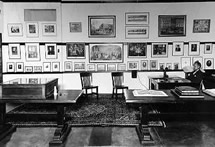 For years Earnest Watson and his private collection occupied Room 114 in East Bridge. Many of Watson's own books and prints were later given to Caltech.
For years Earnest Watson and his private collection occupied Room 114 in East Bridge. Many of Watson's own books and prints were later given to Caltech.
Early Egyptian plumb bob
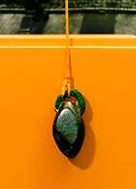 The plumb bob, made of diorite with a bronze ring, is the Archives' oldest scientific artifact. Unchanged in design since 1500 B.C., this surveying tool is still used to determine a vertical line. Acquired by Earnest Watson from the Nahman Collection, Cairo, in 1958.
The plumb bob, made of diorite with a bronze ring, is the Archives' oldest scientific artifact. Unchanged in design since 1500 B.C., this surveying tool is still used to determine a vertical line. Acquired by Earnest Watson from the Nahman Collection, Cairo, in 1958.
Early magnetic compass
 In a brass case, with ornamental inscriptions in Arabic. The magnetic compass appears earlier in Europe than in the islamic world, where it is known only after the twelfth century. Before that time Islamic navigation was purely astronomical and did not make use of the magnetic compass.
In a brass case, with ornamental inscriptions in Arabic. The magnetic compass appears earlier in Europe than in the islamic world, where it is known only after the twelfth century. Before that time Islamic navigation was purely astronomical and did not make use of the magnetic compass.
Purchased for the Institute by Earnest Watson in 1957.
Astrolabe
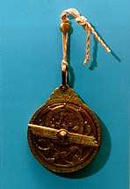 Made of brass with Arabic inscriptions, this astrolabe is of modern construction, ca 1880-1900, probably from Teheran or Isfahan, Iran. Astrolabes were perfected in the Islamic world and first introduced into medieval Europe in the tenth or eleventh century. This instrument, a planispheric astrolabe, was used to tell time, observe the position of celestial bodies and make astrological predictions.
Made of brass with Arabic inscriptions, this astrolabe is of modern construction, ca 1880-1900, probably from Teheran or Isfahan, Iran. Astrolabes were perfected in the Islamic world and first introduced into medieval Europe in the tenth or eleventh century. This instrument, a planispheric astrolabe, was used to tell time, observe the position of celestial bodies and make astrological predictions.
Purchased for the Institute by Earnest Watson in 1957.
Pocket sundial with compass
 Called a horlogium viatorium or traveling timepiece, this German instrument is made of gilt brass. It is signed and dated by a Munich maker: "V[lrich] S[chniep], 1586, VIATORIUM." The instrument is adjustable for elevation and for terrestrial latitudes from 42 to 52 degrees. On the cover is a table of latitudes for various European cities.
Called a horlogium viatorium or traveling timepiece, this German instrument is made of gilt brass. It is signed and dated by a Munich maker: "V[lrich] S[chniep], 1586, VIATORIUM." The instrument is adjustable for elevation and for terrestrial latitudes from 42 to 52 degrees. On the cover is a table of latitudes for various European cities.
Purchased for the Institute by Earnest Watson in 1955.
Turkish Koran, mid-sixteenth century
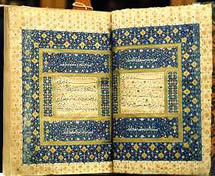 The preeminence of Islamic science in the Middle Ages was rivalled by achievements in the decorative arts. This exquisite manuscript with its beautiful original binding was purchased by Earnest Watson in 1957 and later given to the Institute. The wording on a stamp on the last page links this Koran to the Ottoman sultans. Although scholars have not reached complete agreement on its provenance, it has been suggested that the manuscript was presented to a mosque by Selim II, the son of sultan Suleiman the Magnificent. Selim II reigned from 1566–1574.
The preeminence of Islamic science in the Middle Ages was rivalled by achievements in the decorative arts. This exquisite manuscript with its beautiful original binding was purchased by Earnest Watson in 1957 and later given to the Institute. The wording on a stamp on the last page links this Koran to the Ottoman sultans. Although scholars have not reached complete agreement on its provenance, it has been suggested that the manuscript was presented to a mosque by Selim II, the son of sultan Suleiman the Magnificent. Selim II reigned from 1566–1574.
Universal tangent galvanometer
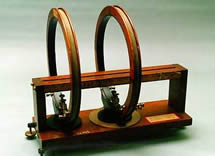 From Bridge Laboratory of Physics. Used at Caltech in freshman physics to demonstrate the presence of electromagnetic fields. Invented in the 1830s, the instrument is so named because the tangent of the angle of deflection of the moving coil (left) was directly proportional to the current in the fixed coil. The manufacturer was Queen and Company of Philadelphia, a prominent American firm in the second half of the 19th century.
From Bridge Laboratory of Physics. Used at Caltech in freshman physics to demonstrate the presence of electromagnetic fields. Invented in the 1830s, the instrument is so named because the tangent of the angle of deflection of the moving coil (left) was directly proportional to the current in the fixed coil. The manufacturer was Queen and Company of Philadelphia, a prominent American firm in the second half of the 19th century.
Quadrant, 1670
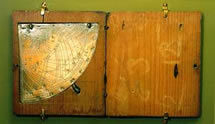 Made of brass, in a wooden case, with plumb bob. Dated 1670 and punched with maker's initials I H. Scratched with date and initials I A, probably by the owner. Equipped with lateral sights, scaled with months, hours and degrees, and bearing celestial projections, the instrument could make topographic, astronomical and chronometric measurements. It may also have served military purposes. Purchased for the Institute by Earnest Watson in 1955.
Made of brass, in a wooden case, with plumb bob. Dated 1670 and punched with maker's initials I H. Scratched with date and initials I A, probably by the owner. Equipped with lateral sights, scaled with months, hours and degrees, and bearing celestial projections, the instrument could make topographic, astronomical and chronometric measurements. It may also have served military purposes. Purchased for the Institute by Earnest Watson in 1955.
Sector, 17th century
 Brass, with Latin inscriptions. Signed by a German maker: "Gottfriedt Reiff Nori[m]b[ergae]" (i.e. of Nuremberg). Galileo's term for the instrument, which he claimed to have invented, was compasso militare e geometrico. Sectors —also called proportional compasses —were generally used, together with rulers and drawing instruments, by military engineers. This specimen has the characteristic proportional scales of Galileo's model but lacks the arc-like inset that fixes the sector into a quadrant.
Brass, with Latin inscriptions. Signed by a German maker: "Gottfriedt Reiff Nori[m]b[ergae]" (i.e. of Nuremberg). Galileo's term for the instrument, which he claimed to have invented, was compasso militare e geometrico. Sectors —also called proportional compasses —were generally used, together with rulers and drawing instruments, by military engineers. This specimen has the characteristic proportional scales of Galileo's model but lacks the arc-like inset that fixes the sector into a quadrant.
Purchased for the Institute by Earnest Watson in 1955.
Manuscript version of Galileo's "Operation of the Geometric and Military Compass" ca 1601
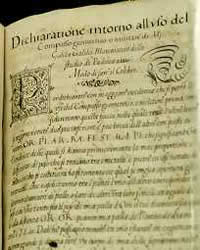 During his early years of teaching at the University of Padua, Galileo composed brief treatises on mechanics, fortifications, cosmography, and the proportional compass. This manuscript, in the hand of a scribe, represents an early variant of the proportional compass treatise and contains substantial passages not in the first printed text of 1606.
During his early years of teaching at the University of Padua, Galileo composed brief treatises on mechanics, fortifications, cosmography, and the proportional compass. This manuscript, in the hand of a scribe, represents an early variant of the proportional compass treatise and contains substantial passages not in the first printed text of 1606.
From the library of Count Giampaolo Rocco, purchased for the Institute in 1955 by Earnest Watson with funds donated by trustee Harry Bauer.
Early edition of Benjamin Franklin's "Experiments and Observations on Electricity" London, 1774
 Personally supervised by Franklin, this fifth English edition is the most correct and complete of the eighteenth-century editions of his famous work on electricity. Typical of the times, Franklin's scientific writings took the form of letters addressed to individuals, in this case Peter Collinson and others. Collinson, an English Quaker who was a cloth manufacturer and botanist, was a Fellow of the Royal Society and in that capacity introduced Franklin's letters into the Society's meetings. Eventually the letters would find their way into the Society's publication,Philosophical Transactions.
Personally supervised by Franklin, this fifth English edition is the most correct and complete of the eighteenth-century editions of his famous work on electricity. Typical of the times, Franklin's scientific writings took the form of letters addressed to individuals, in this case Peter Collinson and others. Collinson, an English Quaker who was a cloth manufacturer and botanist, was a Fellow of the Royal Society and in that capacity introduced Franklin's letters into the Society's meetings. Eventually the letters would find their way into the Society's publication,Philosophical Transactions.
Drawing of an early electrical machine (Not reproducible)
Ascribed to Benjamin Franklin. The Franklin signature may not be authentic. On the reverse of the drawing, the following inscription in a late eighteenth-century hand appears: "This drawing was made by Benjn Franklin and represents his machine as drawn from his first model."
In the first letter to Peter Collinson, which begins Franklin's Experiments and Observations on Electricity, Franklin acknowledges receipt of the gift of "an electric tube," with instructions for rubbing it with flannel to produce a charge. Franklin and his fellows at the Philadelphia Library Company would put this tube and other apparatus to use in a series of dazzling electrical experiments. A number of electrical machines incorporating a glass tube or sphere and similar to the one in the drawing have survived. Several are presumed to have been associated with Franklin, although none is known to have been solely his invention. In the model shown in the drawing, the glass tube is mounted on a framework and turned by a crank, so that the rubbing is done by an adjustable pad from below.
Revolving azimuth quadrant
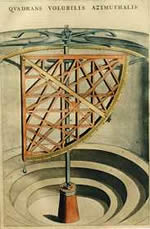 One of Tycho Brahe's instruments, described in hisAstronomiae instauratae mechanica of 1598, and reproduced in a large-scale color print by Joan Blaeu of Amsterdam in 1662. All of Tycho's instruments served to determine the positions of celestial bodies. One of his most impressive, the great revolving azimuth quadrant, was used to determine altitudes and, most accurately, azimuths. Its radius was about 1.5 meters, and Tycho claimed its scale was accurate to one-quarter of a minute of arc. The whole apparatus was mounted on an iron framework set in stone and housed in a specially designed stone crypt with a revolving roof.
One of Tycho Brahe's instruments, described in hisAstronomiae instauratae mechanica of 1598, and reproduced in a large-scale color print by Joan Blaeu of Amsterdam in 1662. All of Tycho's instruments served to determine the positions of celestial bodies. One of his most impressive, the great revolving azimuth quadrant, was used to determine altitudes and, most accurately, azimuths. Its radius was about 1.5 meters, and Tycho claimed its scale was accurate to one-quarter of a minute of arc. The whole apparatus was mounted on an iron framework set in stone and housed in a specially designed stone crypt with a revolving roof.
Kelvin and James White electric balance
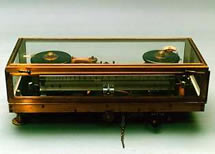 The Kelvin electric balance, patented ca 1894, uses a combination of electromagnetic attraction and repulsion and a conventional beam balance to measure electric current or voltage. The center coil at each end of the beam moves up or down in response to the magnetic fields generated by the currents flowing through the coils above and below. The deflection is then measured bymoving the sliding mass and pointer along the graduated beam to restore the balance. By varying the mass, different ranges of current or voltage can be measured on this one balance. From Bridge Laboratory of Physics.
The Kelvin electric balance, patented ca 1894, uses a combination of electromagnetic attraction and repulsion and a conventional beam balance to measure electric current or voltage. The center coil at each end of the beam moves up or down in response to the magnetic fields generated by the currents flowing through the coils above and below. The deflection is then measured bymoving the sliding mass and pointer along the graduated beam to restore the balance. By varying the mass, different ranges of current or voltage can be measured on this one balance. From Bridge Laboratory of Physics.
Apparatus for demonstrating Lissajous' curves
 French physicist Jules Antoine Lissajous (1822–1880) developed an optical method for studying vibration parameters. This apparatus, manufactured by the firm of Max Kohl of Chemnitz, produces visual representations of vibrations, called Lissajous' curves. The apparatus was used in Caltech's freshman physics lab.
French physicist Jules Antoine Lissajous (1822–1880) developed an optical method for studying vibration parameters. This apparatus, manufactured by the firm of Max Kohl of Chemnitz, produces visual representations of vibrations, called Lissajous' curves. The apparatus was used in Caltech's freshman physics lab.
0 comments:
Post a Comment